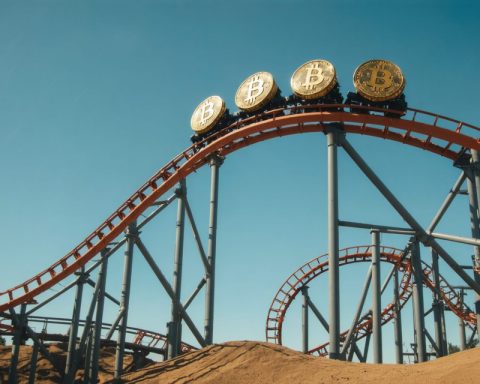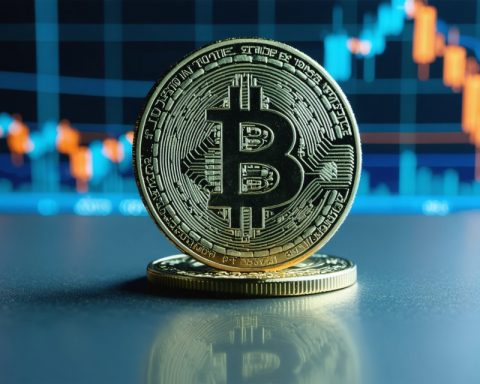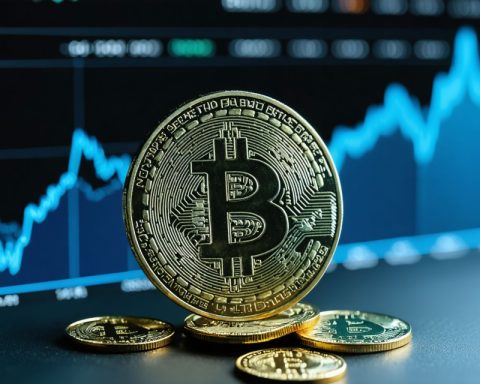- President Trump’s new tariffs aim to reclaim economic independence but have unsettled global markets, raising fears of trade wars.
- Bitcoin’s value plummeted from $87,400 to $82,143, challenging its reputation as a digital safe haven.
- Gold prices soared to a record $3,152 per ounce, reaffirming its status as a secure investment during turbulence.
- The market’s reaction highlights a split: traditional assets like gold remain stable, while digital assets like Bitcoin show vulnerability.
- Bitcoin’s increasing correlation with the Nasdaq 100 suggests its dependency on traditional market trends.
- Economic uncertainty tests asset resilience, with traditional and digital markets traveling divergent paths amidst policy shocks.
A sudden storm swept through global markets as President Donald Trump unfurled fresh tariffs, casting a shadow over stocks and igniting flames in other sectors. Economic independence, he declared, was being reclaimed, but as the dust settles, investors survey the wreckage with anxious eyes.
The announcement sent ripples through financial waters, and as traders scrambled, distinct narratives unfolded across markets. Bitcoin, once heralded as digital gold, stumbled. Its value trickled downward to $82,143, a stark fall from its daily zenith of $87,400. As the crypto-giant faltered, investors questioned the resilience of digital assets amidst global uncertainty.
Gold, in contrast, shone brightly against the darkening financial skies. Like a beacon in a tempest, its price surged to an historic $3,152 per ounce. Investors, seeking a harbor from the gathering storm, gravitated towards the timeless allure of gold. History repeated itself, proving once again gold’s unyielding status as a sanctuary in times of economic unrest.
Trump’s tariffs, targeting imports from allies such as the UK and Israel, stoked fears of escalating trade wars. The bold move aimed to recalibrate trade balances in favor of America, yet left global markets teetering. Traders, caught in the swell, watched as more stable assets like gold surged, underpinning its role as the enduring hedge against turmoil and inflation.
As gold glittered with newfound luster, Bitcoin faced a cold reality. Despite its narrative as a hedge, its course followed a different path, shackled to the fortunes of US equities. Market correlation data revealed an increasing alignment with the Nasdaq 100 index, suggesting Bitcoin’s digital promise may be tethered to traditional market winds.
The split in market responses underscores a growing sentiment: traditional safe havens and speculative digital assets are traveling divergent paths in times of crises. Gold’s ascension speaks to its role as a safeguard against geopolitical and macroeconomic upheavals. Meanwhile, Bitcoin’s stumble underlines its dependency on broader market strength, hinting at vulnerabilities despite its innovative allure.
Investors and economists now ponder with anticipation and anxiety the ripples of Trump’s economic gambles. Will Bitcoin’s perceived kinship to growth stocks further tarnish its bastion of stability narrative, or can it carve an independent trajectory across the financial landscape?
As the global stage reacts to policy shocks, one takeaway emerges starkly: amidst uncertainty, traditional and digital assets alike will be tested, revealing their true resilience in the crucible of economic change.
How Tariff Turbulence Is Shaping the Financial Landscape: Gold vs. Bitcoin
Introduction
In the wake of President Donald Trump’s latest tariff measures, markets around the globe have experienced significant turbulence. These fresh economic policies, aimed at securing economic independence by targeting imports, have created ripple effects across various asset classes. As the world grapples with these changes, investors are evaluating their portfolios, seeking stability and potential growth amid uncertainty.
Gold vs. Bitcoin: A Study in Contrasts
The recent shifts in market dynamics have highlighted the stark differences between traditional safe havens like gold and newer entrants such as Bitcoin.
Gold: The Timeless Beacon
– Historical Performance and Stability: Gold has always been considered a reliable store of value. Its current surge to a historic $3,152 per ounce underscores its continued role as a hedge against inflation and political uncertainty. This is consistent with past economic crises where investors flocked to gold when conventional currencies and assets faced volatility.
– Real-World Use Cases: Beyond being a financial asset, gold is utilized in various industries, including electronics and jewelry. This intrinsic demand adds a layer of security to its valuation.
Bitcoin: The Fledgling Challenger
– Volatility Issues: Bitcoin’s drop from $87,400 to $82,143 demonstrates its susceptibility to market volatility and investor sentiment. Unlike gold, Bitcoin lacks the long historical track record that provides investor confidence during turbulent times.
– Market Correlation: Recent studies have shown Bitcoin’s increasing correlation with tech-heavy indices like the Nasdaq 100. This tethering suggests that Bitcoin may behave more like a tech stock than an uncorrelated safe haven.
Pressing Questions
Is Gold Still a Good Investment?
Gold remains a reliable choice for those seeking to hedge against market instability and inflation. Its limited supply and inherent demand suggest continued strength.
Can Bitcoin Regain Its Stability Narrative?
Bitcoin’s potential for growth lies in its ability to break away from correlations with traditional equities. Emerging use cases, increased institutional interest, and regulatory clarity could strengthen its position as a digital asset within a diversified portfolio.
Market Forecasts & Industry Trends
1. Future of Tariff-Driven Market Dynamics: If tariffs continue to strain international trade relations, commodities like gold may further increase in value as safe havens.
2. Tech Integration and Blockchain Adoption: As blockchain technology matures, enhanced use cases for Bitcoin and other cryptocurrencies could drive innovation, potentially increasing long-term value despite short-term volatility.
Actionable Tips for Investors
– Diversification is Key: In uncertain times, balance portfolios with a mix of traditional assets like gold and potential high-reward assets such as Bitcoin.
– Stay Informed: Keep abreast of global policy changes and market responses. This allows for quicker adjustments to investment strategies.
– Consider Dollar-Cost Averaging: To manage volatility, especially in crypto markets, consider buying small amounts over time rather than a lump sum.
Final Thoughts
The financial landscape is continuously reshaped by geopolitical maneuvers and technological advancements. Understanding these changes and adjusting strategies accordingly is crucial for both individual and institutional investors. As the global economy evolves, the roles of traditional and digital assets will be tested, revealing their true resilience and potential.
For more insights into financial markets and investment strategies, consider exploring resources from Bloomberg and Financial Times.


















